-
Posts
794 -
Joined
-
Last visited
-
Days Won
56
Content Type
Profiles
Forums
Events
Downloads
Store
Gallery
Articles
Everything posted by terrysoldpennies
-
Hi Richard. I wondered if I might ask you a few things. The 2* 145, have you heard of any more being found other than the four I already know of.
2 You list your 1967 missing waves as R8, how many of this type do you know of .
3 I have a 1953 penny with the standard B+b [1+B pairing, but I think it might be a matt finish, as it has a strange kind of sheen, most unlike the normal production coin. I don't have another toned matt finish to judge it by, except a 1986 matt and polished 2p proof that's in a bright condition. Have you heard of the possible existence of this type. I think i might get it checked out at the mint in the summer while on holiday. Would you know who to contact about taking the coin along in person, as I don't trust the post with it Terry















